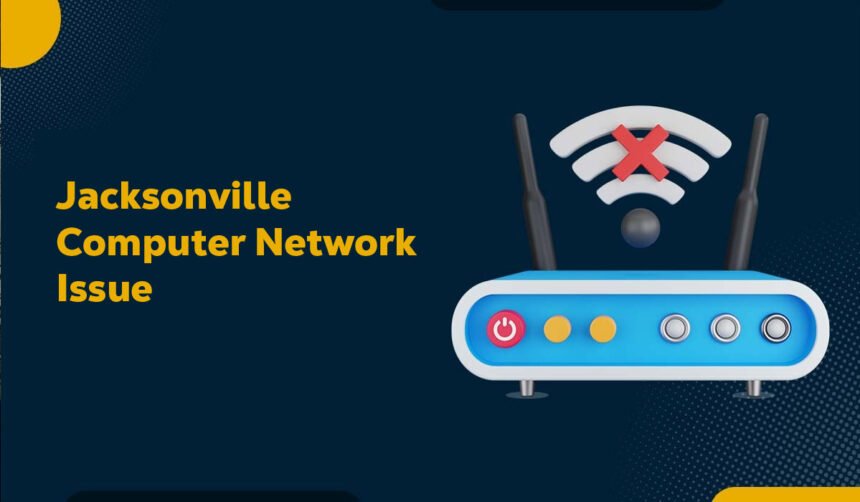In today’s technology-driven world, the reliability of computer networks is absolutely critical to the smooth functioning of public infrastructure, government services, and private enterprises. This reality was sharply highlighted by the recent Jacksonville computer network issue, which brought daily operations in Florida’s most populous city to a standstill. On a seemingly regular Wednesday morning, thousands of residents, businesses, and city officials were caught off guard as Jacksonville’s key digital services collapsed without warning. Websites like Jacksonville.gov and JaxReady.com became inaccessible, the city’s help hotline 630-CITY went down, and mobile applications across various departments failed to respond.
What initially seemed like a brief outage due to routine maintenance quickly turned into a city-wide crisis as it was revealed that the incident stemmed not from a cyberattack, as many feared, but from a critical hardware failure. This seemingly minor glitch in the infrastructure caused ripple effects that affected everything from courthouse documentation to tax services and beyond. It serves as a sobering reminder that even in the absence of malicious activity, poor infrastructure planning and outdated technology can lead to devastating consequences for public trust, operational functionality, and economic stability.
What Happened in Jacksonville? – A Quick Recap
The Jacksonville computer network issue unfolded quickly and unexpectedly, sending shockwaves through city operations. The problems began on a Wednesday morning when multiple residents started reporting that the city’s websites were either unresponsive or completely down. Within hours, it became clear that the issue was not limited to just online access; city departments, including the Tax Collector’s Office and the Public Defender’s Office, were experiencing deep internal connectivity issues.
Employees reverted to manual processes, and in the Duval County Courthouse, staff had to resort to using paper documentation to continue functioning. Initially, the city described the issue as a “configuration problem,” which many interpreted as a software misstep or an IT oversight. However, after a more thorough investigation, the root cause was revealed to be a hardware malfunction that had disrupted the core networking components.
This revelation was communicated to the public through news outlets like Action News Jax, which reported that while no cyberattack had occurred, the city’s infrastructure had clearly failed to provide the resilience expected in such critical systems. Jacksonville Mayor Donna Deegan emphasized that the city had already addressed immediate concerns but acknowledged the glaring need for “robust infrastructure and proactive maintenance” going forward.
The Root Cause – Technical Breakdown
A deeper examination of the Jacksonville computer network issue reveals that the primary failure was hardware-related, involving aging components that were not sufficiently monitored or replaced in time. The system’s backbone infrastructure—likely involving core switches, routers, or servers—encountered a malfunction significant enough to disable inter-departmental connectivity and public access portals. The fact that this issue was first labeled as a “configuration error” suggests that initial attempts to resolve it focused on network routing or firewall settings, which can commonly cause service disruptions if misconfigured.
However, once IT teams diagnosed the deeper failure, they found that the problem was actually physical: a piece of networking hardware had failed, potentially due to wear and tear or environmental stress. While the city was quick to reassure the public that no data had been compromised, the very occurrence of this event pointed to larger issues within Jacksonville’s IT strategy—namely, the lack of predictive maintenance, redundant systems, and advanced monitoring tools. Local reports also confirmed that several systems continued facing intermittent issues days after the primary services were restored, further demonstrating how damaging and far-reaching a single point of failure can be in a modern digital network.
Immediate Impacts of the Network Outage
Disrupted Public Services
One of the most tangible effects of the Jacksonville computer network issue was the massive disruption to essential public services. From the very beginning of the outage, departments across the city found themselves cut off from their internal tools, databases, and communication systems. The Duval County Tax Collector’s Office could not process vehicle tags, issue licenses, or manage payments, leading to long lines, delayed appointments, and frustrated citizens.
The Duval County Courthouse similarly experienced serious operational challenges, as courtroom processes that depended on digital records had to revert to handwritten logs and verbal scheduling. These manual workarounds not only slowed down operations but also risked documentation errors and created bottlenecks across the system. Citizens who relied on the city’s websites for vital information—such as emergency preparedness from JaxReady.com—found themselves completely cut off, leaving many feeling uncertain and anxious during the prolonged downtime.
Manual Workarounds
In response to the failure, Jacksonville city employees were forced to fall back on manual methods to keep services running, which highlighted both the fragility of the existing digital systems and the resilience of the workforce. For instance, courthouse clerks and legal staff wrote down appointments and filings by hand, while call centers took notes manually instead of relying on customer service management software.
These temporary fixes were labor-intensive, error-prone, and incredibly inefficient, but they were the only way to maintain continuity in the absence of functioning technology. Unfortunately, this approach placed immense pressure on already burdened staff, leading to longer processing times, increased stress, and the potential for serious service delays that extended beyond the duration of the outage itself. It became abundantly clear that without automated systems and reliable connectivity, public services cannot scale or respond effectively to community needs.
Business and Economic Disruptions
The economic consequences of the Jacksonville computer network issue were not limited to the public sector. Many local businesses that depend on timely city services—such as permitting, licensing, and official approvals—found themselves stalled during the outage. Real estate transactions were delayed due to unavailable title checks and property records, and contractors couldn’t secure the necessary permits to begin new construction.
Transportation-related services, such as commercial vehicle registrations or taxi licensing, were similarly affected. The disruption, though temporary, created a significant backlog that had financial repercussions for businesses relying on fast, responsive municipal operations. Moreover, the city’s expenditure on emergency support services, temporary infrastructure patches, and expert consultations added to the overall cost of the incident. As IT consultant David Jacobs noted, “Every minute of downtime costs organizations—not just in revenue but also in reputation.”
Broader IT Risks Exposed
The Jacksonville incident serves as a sobering reminder that hardware failures can be just as disruptive, if not more so, than cyberattacks. While the term “cybersecurity” often dominates IT discussions, the reality is that even simple mechanical or electrical breakdowns in hardware can lead to catastrophic failures. In Jacksonville’s case, the absence of redundant systems—such as secondary switches, backup servers, or alternative power sources—meant that the entire network was overly dependent on a single point of success.
The consequences of this architectural oversight were significant: an issue that could have been contained with proper failover mechanisms instead brought down multiple departments and services across the city. Such failures are often magnified when real-time monitoring is absent, as was seemingly the case here, which delays incident detection and resolution. Beyond technical concerns, there’s also the matter of public confidence. When residents see essential services fall apart due to what appear to be preventable errors, it erodes trust in the city’s leadership and its ability to manage digital transformation responsibly.
Common Causes of Network Outages (Beyond Jacksonville)
Hardware Malfunctions
The most direct cause of the Jacksonville computer network issue was a hardware malfunction—something that continues to plague many organizations with outdated infrastructure. Devices like routers, switches, modems, and servers have a lifespan, and once they exceed it, performance becomes unpredictable. Aged components may experience voltage irregularities, overheating, or software incompatibility, all of which can lead to network failure. If not identified early through regular audits and diagnostics, these vulnerabilities can go unnoticed until a catastrophic outage occurs.
Configuration Errors
Many network disruptions also arise from configuration mistakes, especially during maintenance or upgrades. Incorrect settings on routers, DNS servers, or firewalls can unintentionally block access to internal systems or the internet. In fast-paced environments where multiple administrators might manage network components, these errors can be hard to trace. A single change in an IP table or DNS rule can cascade across the entire network if not double-checked, making robust configuration change policies essential.
Bandwidth Overload
Today’s networks are under constant strain from increased data usage due to remote work, cloud applications, video conferencing, and IoT devices. If bandwidth is not properly scaled or prioritized through Quality of Service (QoS) settings, networks can slow to a crawl or stop functioning altogether. Overloaded bandwidth was not the cause in Jacksonville’s recent event, but it remains a common source of downtime across the country and should always be considered in preventive planning.
Environmental Factors
Jacksonville’s location makes it particularly vulnerable to environmental stressors such as hurricanes, high humidity, and lightning storms. These factors can damage cabling, fry circuitry, or degrade equipment prematurely. Salt in the air from coastal winds can also corrode exposed metal parts in networking gear. Therefore, investing in protective infrastructure—such as sealed enclosures, surge protectors, and climate-controlled server rooms—is essential in cities with such geographic risks.
How Jacksonville Responded – Crisis Management
Jacksonville officials were quick to pivot to crisis management mode once the scale of the network failure became apparent. Manual processes were activated across essential departments, while IT teams worked round-the-clock to identify and isolate the failure. The city used press releases and real-time updates via local media to inform the public about the situation and next steps. Mayor Donna Deegan was transparent in her public communication, reiterating that the problem was not a result of cybercrime and assuring residents that systems would be restored progressively. The phased rebooting of the city’s network began soon after the hardware was replaced and tested, with services coming back online in stages to ensure no further disruptions occurred due to rushed deployment. While the city was able to restore operations, the response also revealed the need for a more comprehensive emergency playbook, including formal incident response procedures and advanced communication channels.
Key Lessons for IT Professionals Everywhere
Prioritize Infrastructure Maintenance
Regularly inspect network hardware and replace old equipment before it fails.
Build Redundant Systems
Use backup servers and cloud solutions to keep systems running during outages.
Use Real-Time Monitoring Tools
Tools like PRTG or SolarWinds can detect issues early through alerts and performance tracking.
Improve Crisis Communication
Prepare messages in advance, use alerts, and train staff to respond clearly during disruptions.
Jacksonville Network Issue as a Case Study
This event can be used in IT courses to show how technical failures affect real operations. It also shows why cities must upgrade systems and plan for emergencies, as similar risks exist everywhere.
Practical Fixes for Small Jacksonville Network Issues
For Home Users and Small Businesses
Restart your router, keep firmware updated, use surge protectors, and install Wi-Fi extenders to fix weak signals.
When to Call a Professional
Contact IT support if problems persist, hardware is damaged, or you’re unsure how to fix network settings.
Jacksonville’s Unique Networking Challenges
The city’s weather, coastal humidity, and wide layout cause added stress on network systems. Many government offices still use outdated tech, increasing risk.
Choosing the Right IT Support in Jacksonville
Choose providers familiar with local conditions. Look for quick support, full-service options, and trusted names like CompassMSP or TickTockTech.
Preventing Future Jacksonville Computer Network Issues
Do regular health checks, plan for outages, train your team, and set up backup systems with automatic switching to keep services online.
Conclusion
The Jacksonville network issue shows how one failure can impact an entire city. Staying prepared with strong systems, backups, and response plans is key for all IT teams.
FAQs About Jacksonville Computer Network Issue
1: What caused the Jacksonville computer network issue?
The Jacksonville computer network issue was caused by a hardware failure that affected the city’s core IT systems. Although it was first thought to be a configuration problem, further investigation revealed that aging or faulty equipment was the real reason behind the major service disruption. It was not a cyberattack, according to city officials.
2: Which services were affected during the Jacksonville network outage?
Several key services were impacted, including Jacksonville.gov, JaxReady.com, the 630-CITY help line, and mobile apps. Internal systems used by the Duval County Courthouse, Public Defender’s Office, and Tax Collector’s Office were also disrupted. Many departments had to switch to manual processes during the outage.
3: How long did it take Jacksonville to restore its network services?
It took several days to fully restore all services. Some systems were back online within 48 hours, while others required more time due to ongoing troubleshooting. The city restored services in phases to ensure systems were stable and safe before going live again.
4: Was Jacksonville hacked during the network outage?
No, Jacksonville was not hacked. Officials confirmed that there was no evidence of a cyberattack or data breach. The disruption came from a technical failure in the hardware, not from any malicious activity.
5: How can Jacksonville prevent future network issues?
To prevent future problems, Jacksonville needs to:
-
Replace aging hardware regularly
-
Use backup systems and redundancy
-
Monitor networks 24/7 with alerts
-
Train staff on crisis response
-
Schedule preventive maintenance
These steps can protect against both technical failures and cybersecurity risks.
You May Also Read: GoCryptoBet.com Review: Powerful Crypto Betting Site You Can Trust
For More Information, Visit Dotmagazine









